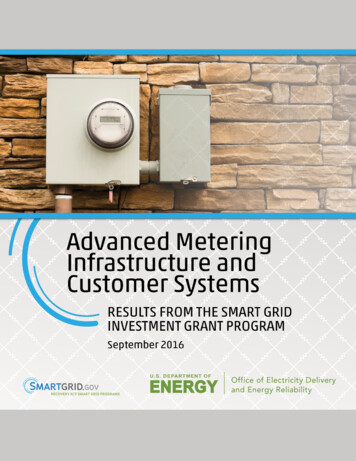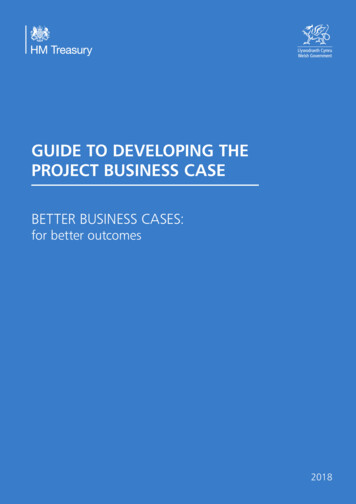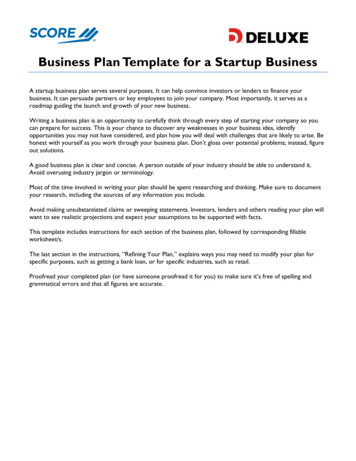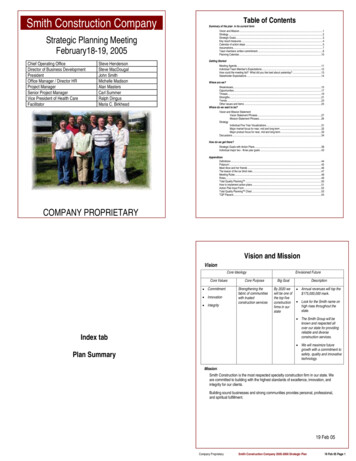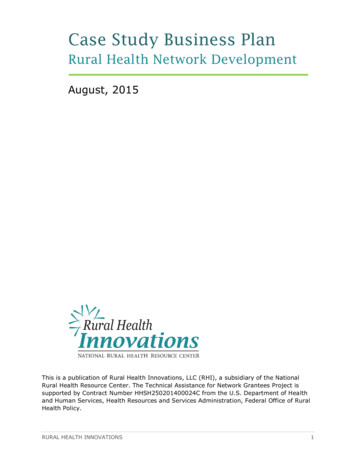
Transcription
Case Study Business PlanRural Health Network DevelopmentAugust, 2015This is a publication of Rural Health Innovations, LLC (RHI), a subsidiary of the NationalRural Health Resource Center. The Technical Assistance for Network Grantees Project issupported by Contract Number HHSH250201400024C from the U.S. Department of Healthand Human Services, Health Resources and Services Administration, Federal Office of RuralHealth Policy.RURAL HEALTH INNOVATIONS1
TABLE OF CONTENTSNetwork Description. 3Mission and Values . 3Vision . 3History and Culture . 3Strategic Objectives . 3Business Structure and Governance . 4Market Analysis and Plan . 5Rural Health Care Environment:. 5Rural Health Network Members and Customers: . 6Member and Customer Needs Assessment: . 6Value Proposition of Products and Services: . 7Promotion and Communication . 8Leadership and Operations Review. 9Leadership Team and Skills: . 9Key Activities. 9Key Resources and Infrastructure: . 10Key Partners . 10Evaluation Dashboard: . 11Financial Outlook . 12Estimated Operations Cost . 12Projected Revenues . 12Table 1: Projected Revenue and Cost by Product and Services . 13Membership Dues Structure: . 14Table 2: Membership Dues Structure . 14RURAL HEALTH INNOVATIONS2
Network DescriptionMission and Values“The mission of Rural Health Network (RHN) is to act as a convener andfacilitator of change within the rural health care system in order to ultimatelyimprove the health of our rural community. We will meet this missionthrough our values of collaboration, where we work as a team with healthcare and community organizations to provide services, honesty, where westrive to provide honest and informative services that support the quality ofcare, and integrity where we support those health care communityorganizations with professionalism and integrity”, per the RHN website.VisionRHN is seeking population health in our community which is ranked at thetop of the State’s health outcomes.History and CultureRHN formed in 2008 through a Rural Health Network Development grantaward funded by the Federal Office of Rural Health Policy (FORHP), Healthand Human Services Administration of the U.S. Department of Health andHuman Services (HRSA). Through this grant, the focus and purpose of RHNis to improve the access, scope and viability of rural health care in thehistorically underserved populations within our rural communities. Thebusiness model of a rural health Network is applicable and coherent forsuccessfully achieving the purpose of RHN.The relationship building and problem solving culture of the organization isillustrated by its formation out of a community action agency in our ruralcommunity and its core values of collaboration, honesty and integrity. Thisculture can be seen in the effort and success that RHN has had in buildingrelationships between health care organizations, individual health carepractitioners, public health agencies, economic development and highereducation institutions throughout the region.The passion of improving overall health in our rural community drives RHN;supported and nurtured through a culture of collaboration and solutions.Strategic ObjectivesIn 2013, RHN completed a comprehensive strategic planning retreat withNetwork board members and community stakeholders. The result of thisplanning event included six strategic objectives to use as a guide for theRURAL HEALTH INNOVATIONS3
organization over the next 2-3 years for establishing initiatives that willmove the Network toward its vision and mission.RHN Strategic Objectives: Network Sustainability through Revenue Generating Services Provide Public Relations through Outreach and Education Encourage Membership Interaction Increase Board Engagement Promote Network Visibility Increase Provider InvolvementRHN embraces the concept of process improvement and organizationeffectiveness. The Balanced Scorecard methodology is used to manageprogress toward its strategies and ultimately its vision.Business Structure and GovernanceRural Health Network will be a 501c3 organization by the end of 2014. RHNis made up of 6 organizations, as such, it operates exclusively for charitableand educational purposes. Three of the organizations, as well as foundingmembers are rural hospitals, two are family medical centers who aredesignated as Federally Qualified Health Clinics (FQHC), and the sixthmember is a community action agency. Hospital – Community HospitalHospital – Community HospitalHospital – Community HospitalFamily Medical Center – FQHCFamily Medical Center – FQHCCommunity Action Agency – Community MemberThe Board of Directors (Board) consists of voting members and excludesRHN employees. Board members serve a term of three years withoutcompensation and are elected into position by a majority of a quorum of theentire Board. The Board meets quarterly to manage the governance,mission, vision and strategies of RHN. An Executive Director reports to theBoard and is responsible for managing the day to day operations andbusiness of RHN including duties incident to the function of a chief executiveoffice. The Executive Director shall not be an officer or director of the Boardaccording to the RHN by-laws.RURAL HEALTH INNOVATIONS4
Market Analysis and PlanRural Health Care Environment:On a national level, rural health care is undergoing a significant transitionfrom a volume-based model to a value-based model. This transitionrequires the clinical, operational and financial operations within the healthcare organizations to focus on improving health in communities, providingbetter care, and reducing costs. Evidence of these changes to the deliveryof care are seen in the creation of Accountable Care Organizations, foundingmembers and Patient Centered Medical Homes, increased reporting ofquality health outcome measures, and new outreach and educationprograms to proactively address chronic diseases and increase patientengagement.The rural health care environment in the southeast region has significantpopulation health and wellness challenges. They are in the lowest quartileranking in regard to county health outcomes and health factors, as definedby County Health Rankings and Roadmaps, 2013. Health outcomes includemortality and morbidity measures of premature death, poor health, poorphysical and mental health days, and low birth weight. Health factorsincluded health behaviors, such as tobacco and alcohol use, limited access tocare due to being uninsured, social and economic factors such asunemployment, poverty levels for children, violent crime rates and physicalenvironment issues such as water quality issues, access to recreationalfacilities and fast food restaurants.Additionally, one of the RHN member hospitals, Hospital 1, completed aCommunity Health Needs Assessment in March, 2013. Following are thehealth needs recommendations from the community identified in that report.In regard to the health data, county data and information report, and thecommunity survey results, the top health concerns identified by communitymembers were as follows: Availability of doctors and difficulty attracting new providersPotential hospital closingPhysician privileges at hospital are importantConfusion of hospital status and hospital servicesHiring local employees and need to share servicesUninsured population seeking emergency room servicesThese recommendations are both relevant and pertinent to all members ofRHN, therefore are included in this section of the business plan to provideinsights on the Network members and customers.RURAL HEALTH INNOVATIONS5
Rural Health Network Members and Customers:RHN membership is defined by signing a Memorandum of Agreement withthe Network, paying annual dues, and participating in the governance of theNetwork as stated in the Network by-laws. For additional detail, seeattached RHN governance by-laws, Appendix A. Current members of RHN,as of spring 2014, include the following health care organizations: Family Medical CenterFamily Medical CenterMemorial HospitalMemorial HospitalHospitalMember and Customer Needs Assessment:Identification and prioritizing of member and customer needs was completedusing a Business Model Canvas Needs Assessment Structure. The needs andexpectations of RHN members and customers are focused on improving thehealth outcomes of their patients, improving their own internal operationaland clinical processes and reducing costs or saving money. Specific findingsinclude: Improve efficiencies and effectiveness of HR Departmento Reduce chance of litigationo Reduce costso Reduce risk of privacy breacho Avoid stress for HR staff and supervisorsImprove functionality of EHR platformo Reduce frustration of clinical providers and super-users usingEHRo Reduce frustration of staff using technologyo Increase staff productivityo Avoid hiring additional staff by increasing productivityo Avoid hiring additional operational or clinical staffo Save moneyAchieving goal of improved population behavioral health factorso Address community perception that local hospital’s partners areunwilling to collaborateo Increased patient volume and satisfactionRURAL HEALTH INNOVATIONS6
Value Proposition of Products and Services:Product/ServiceHealth care HRserviceMeet Member NeedsAlign w/ OrganizationMission, Vision, Strategies Reduce change of ligitigation Reduce costs of service orpayroll Improve efficiencies Avoid stress for HR staff andsupervisors Reduce risk of privacy breach Reduce frustration of clincialproviders and super-users ofEHR Reduce frustration of staffusing tecnology Avoid hiring additionaloperational or clincial staff Improve functionality of clincalEHR platform Save money on IT expertiserates S: Network sustainabilitywith revenue streamV: Seek population healthConsulting:Negotiation expertisewith health carevendors Avoid hiring additional staff byincreasing prodcutivity withoutsourcing skills Saving money with bettercontract rates M: Act as a convenerV: Seek population healthConsulting:Health care publicrelations expertisefor promotingmembers’ valueConsulting:Knowledge sharingand health careleadershipdevelopment support Increase patient volume S: Provide public relationsS: Promote network visibility Increase staff productivity andcustomer satisfaction S: Encourage membershipinteractionS: Increase boardengagementV: Seek population healthM: Act as a convenerConsulting:Community coalitionexpertise forpopulation healthleadership Address community perceptionthat local hospital’s partnersare unwilling to collaborate Achieving goal of improvedpopulation behavioral healthfactorsHealth IT services andexpertiseRURAL HEALTH INNOVATIONS S: Network sustainabilitywith revenue streamV: Seek population healthS: Increase providerinvolvemnetS: Increase boardengagementV: Seek population healthM: Act as a convener7
RHN products and services are offered to members and customers atdifferent rates. For the purpose of this segment of the business plan,products and services will be described without differentiating the categoryof membership or corresponding rate.Promotion and CommunicationRHN contracted with an Advertising Company in July, 2013 to develop anintegrated marketing and communication plan with the purpose ofdeveloping relationships and improving communication with customers. Thefollowing recommendations were proposed by the advertising company andwill be used as a guide by RHN over the coming 6-12 months for developingrelationships and improving communication:1. Actively seek opportunities to engage with consumer audience groupseven though initially they are slated as secondary audience members.2. Seek out partnerships that expose the RHN brand to consumeraudiences.3. Consider a “special event” to introduce RHN to the general public.4. Make Accountable Care Act (ACA) education fun through trivia games,promotions, crossword puzzles and other activities that engage andeducate constituents. Incorporate giveaways (i.e. gift cards, etc.) toinspire participation.5. Use social media campaigns to build consumer email marketing list.6. Distribute ACA educational materials via newspaper inserts as well asthrough Public Relations and designated “distribution sites”.7. Actively survey consumer audience members to garner a betterunderstanding of their needs, for example education / resources /technical assistance.8. Actively reach out to current funding sources and prospective sources.This includes liking their Facebook pages and including them on emailmarketing correspondence.9. Determine program focus for the next 24-36 months.10. Identify opportunities that foster sustainability.RURAL HEALTH INNOVATIONS8
Leadership and Operations ReviewLeadership Team and Skills:Together, the Network Director and IT Manager are an effective leadershipteam because of their diverse knowledge and skill sets. They work welltogether in a culture of collaboration and customer focus. They hold weeklyphone calls for leadership meetings and monthly planning meetings inpreparation for RHN Board meetings.The Network Director’s leadership strengths include seeing the big picturefor the organization within the community, region and state, articulating thesuccesses of the Network and how each of the members can be part of theNetwork’s future, and persistence in overcoming the challenges ofcollaboration. She understands rural culture, thinks like an entrepreneurand has experience with marketing and communication. She can think onher feet and keep the vision in view through the transition of health caretoward a value-based health care model. She has been successful with thestart-up of RHN over the past three years and welcomes the challenge asthe Network shifts its governance and business structure from a fully grantfunded organization to a sustained 501c3 rural health Network.Leadership within the IT Service of RHN has been focused on the customer.The IT Manager has a deep knowledge of IT and the ability to resolvecomplex issues as they arise. Over the past two years, he has worked witha small team of IT staff to troubleshoot a broad array of technology issues,such as workstation hardware and software, broadband, wireless networks,and server maintenance. Additionally, the IT Manager’s knowledge of theelectronic health record (EHR) platform, eClinicalWorks, and acts as a liaisonbetween the customer and vender support system. When working with hiscustomers, the combination of his calm demeanor and his deep knowledgeprovide the ability to explain technical issues in a way that the customerfeels comfortable, therefore bridging the gap between IT and the user.Key ActivitiesRHN has been working toward becoming its own non-profit organization.The Network Director has worked with the Board to write and approve RHNgovernance by-laws, agrees on membership tiers and a dues structure, andfiled for 501c3 status. RHN has also set pricing for members and nonmembers and has begun offering a new HR service in the past year.RHN is increasingly focused on its customer’s needs and promoting theNetwork’s services including community outreach and wellness education.RURAL HEALTH INNOVATIONS9
The new marketing materials and recently launched website will continue tobe utilized for effective communication, promotion and outreach. Newpotential members for the Network have been identified along with strategicpartners that will complement the work of the Network and strengthen itsoutreach efforts in the community.Key Resources and Infrastructure:The Network Director and IT Manager are focused on specific Network effortsand strategies and are effectively allocated. The Network Director isallocated 50% to managing the Network and 50% to consulting services.Although her time, abilities, knowledge and energy are split betweenoperations and consulting, she utilizes contracted expertise and technologythat allows her to effectively manage diverse work. For example, the HRService is provided through a contractual relationship with the HumanResources Compliance System and the newsletter and marketing materialswere developed by a respected marketing organization/advertising company.The IT Manager is allocated 100% to IT Services. His time, abilities,knowledge and energy are focused on providing excellent service to hiscustomers so that they are successful at effectively utilizing their technologyto further their work. IT Services utilizes a customer relationshipmanagement tool to track issues and provide timely service. These toolsprovide a means for bi-directional communication with customers andvendor support services. Additionally, he leverages the eClinicalWorks helpdesk to support his customer’s health information technology issues andquestions.Key PartnersThe Community Action Agency, Family Medical and Hospital are membersand also key partners. They have provided significant in-kind support to theNetwork in the form of grant writing assistance, office space and supplies.The Network Director uses her proactive relationship building and passionateapproach for building community and finding partners that can provideneeded support and services to her members. For example, she has a seaton the State HIE Board as the only rural voice in the region. Other keypartners of RHN include the State Office of Rural Health and the RegionalExtension Center.RURAL HEALTH INNOVATIONS10
Evaluation Dashboard:NOTE: This is a component of the Strategic Plan. At the time of publishingthis tool, they have not completed this dashboard for their new StrategicPlan. Resource for this section include the Sample Strategic Plans (pages25–27). Or contact us at RHI; NetworkTA@RuralCenter.orgRURAL HEALTH INNOVATIONS11
Financial OutlookEstimated Operations CostRHN has benefitted since 2012, financial performance year-1, as a recipientof the Health and Human Services Administration of the U.S. Department ofHealth and Human Services (HRSA) Federal Office of Rural Health Policy(FORHP) grant program, The Rural Health Information Technology NetworkDevelopment (RHITND). In this grant, the Network received 300K per yearin federal fiscal year 2012, 2013, and 2014, years 1-3, to spend on Networkstart-up and development as well as providing a means for their memberorganizations to meet Meaningful Use criteria through IT staffing, hardware,software, marketing, training and subscription fees to the state’s healthinformation exchange. The effort this took required infrastructure andresources of approximately 300k per year. In 2014, year-4, RHN isplanning to transition its governance from a project of the primary grantfiduciary agent, to a stand-alone 501c3 non-profit organization that benefitsand supports the success of its member organizations to improve health carein the region.The operating expenses will be reduced at the end of the grant funding cyclein September, 2014 to approximately 170k with the reduction ofinformation technology staff time, reduction in time spent managing thegrant, the ending of software and hardware purchasing, and subsidy of theHIT subscription fee. However, current services; HR service, IT service andExecutive Director consulting will continue to be available to membersfollowing the conclusion of the grant funding period.Projected RevenuesThe projected Network revenue and cost for 2014 and 2015, years 4 and 5from the start of the RHITND grant, is provided in Table 1 below. TheNetwork is projected to have a positive net income of over 10k in bothyears showing a sustained financial viability. The assumptions include a100% member participation rate in the HR Service in year-4, growth to nonmember organizations in year-5, a 100% member participation rate in ITService and a 50% member participation rate in the Executive DirectorConsulting service.RURAL HEALTH INNOVATIONS12
Table 1: Projected Revenue and Cost by Product and ServicesYear-4 Forecast: 2014-2015Year-5 Forecast: 2015-2016SERVICERevenueCostNetRevenueCostNetHR service 9,000 8,873 2,527 12,720 8,873 3,847IT service 124,661 90,033 34,628 124,661 90,033 34,628Exec. Directorconsulting 37,507 72,236- 34,729 37,507 72,236- 34,729Grant funding 0 0 0 0 0 0Membershipdues 7,750 7,750 7,750TOTAL 181,319 10,176 180,239RURAL HEALTH INNOVATIONS 171,142 7,750 171,142 11,49613
Membership Dues Structure:RHN will begin collecting membership dues in 2014. The membership duesstructure is provided in Table 2 below, with a current income of 7,750 peryear. In this projection there is no assumption of membership growth.Table 2: Membership Dues tHospital 11 1,500AnnualHospital 21 1,500AnnualHospital 31 1,500AnnualFamilyMedicalCenter 1 1,500Annual1FamilyMedicalCenter 2 1,500Annual1CommunityActionAgency1MemberCOUNT6 250Total AnnualMembershipDues IncomePricing tiersbased on typeoforganization01 0 250 100RURAL HEALTH INNOVATIONS 250Annual005 7,5001-3: 500,4 : 1000 1500 7,750 150014
Case Study Business Plan Rural Health Network Development August, 2015 This is a publication of Rural Health Innovations, LLC (RHI), a subsidiary of the National Rural Health Resource Center. The Technical Assistance for Network Grantees Project is supported by Contract Nu



